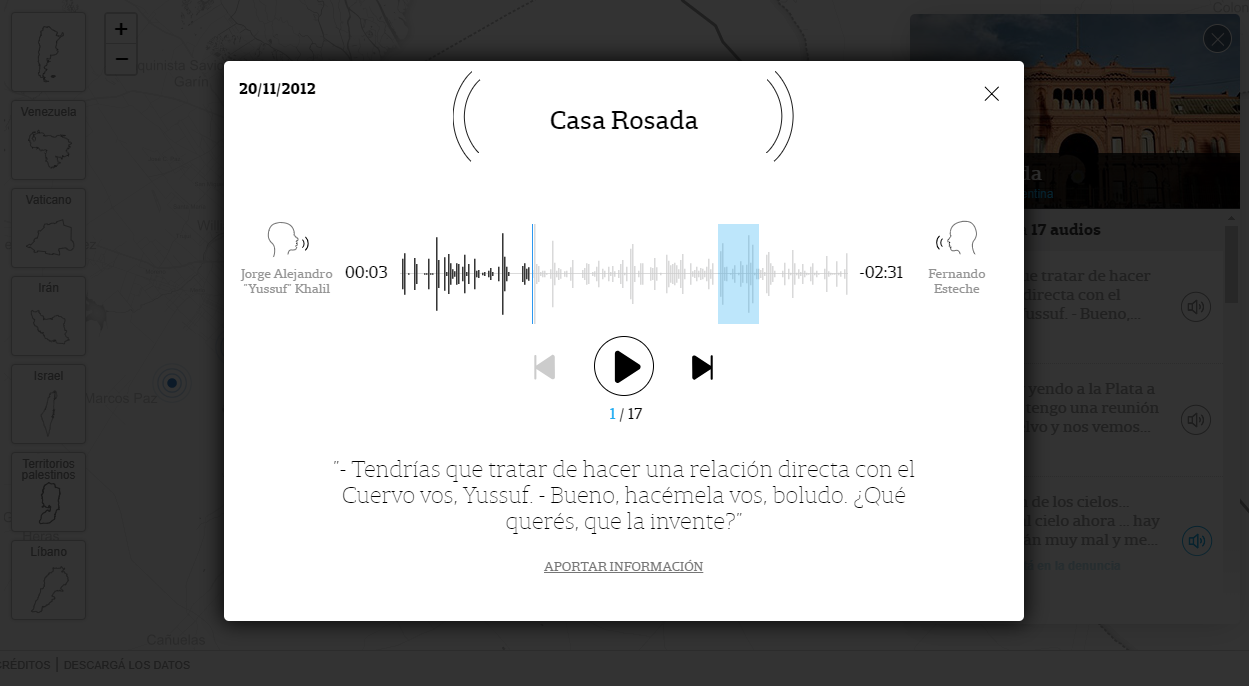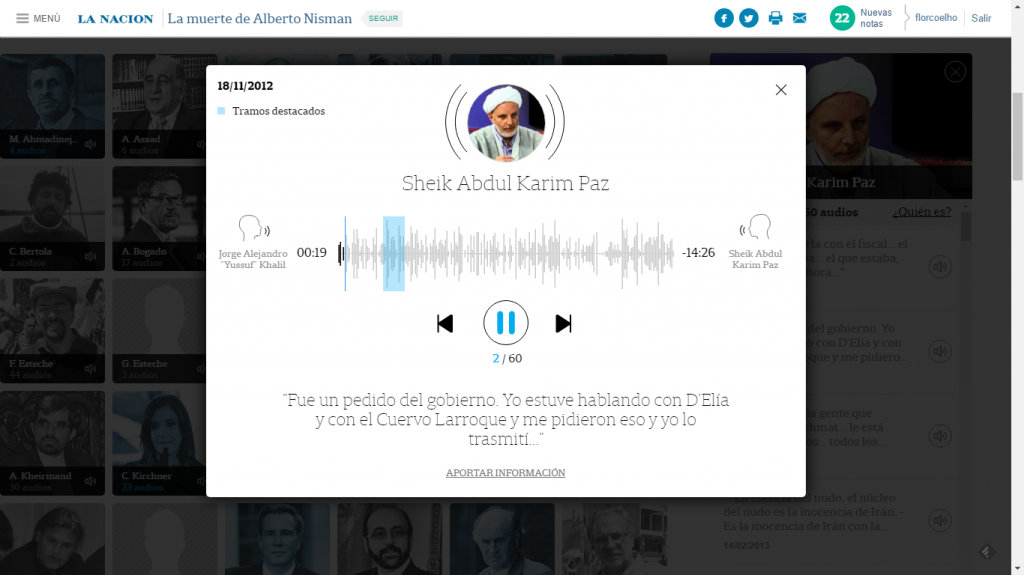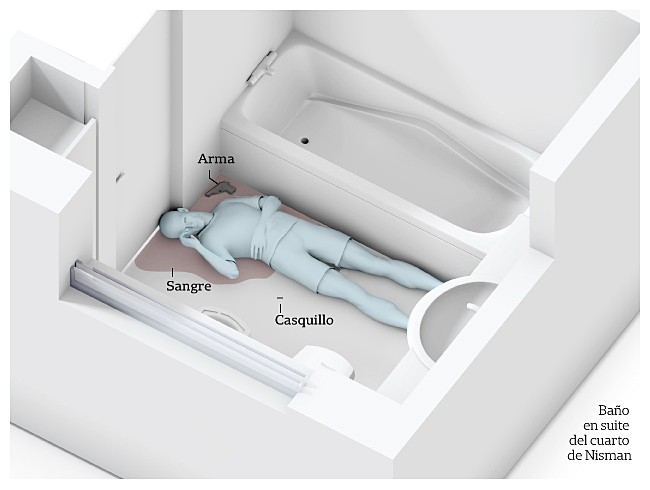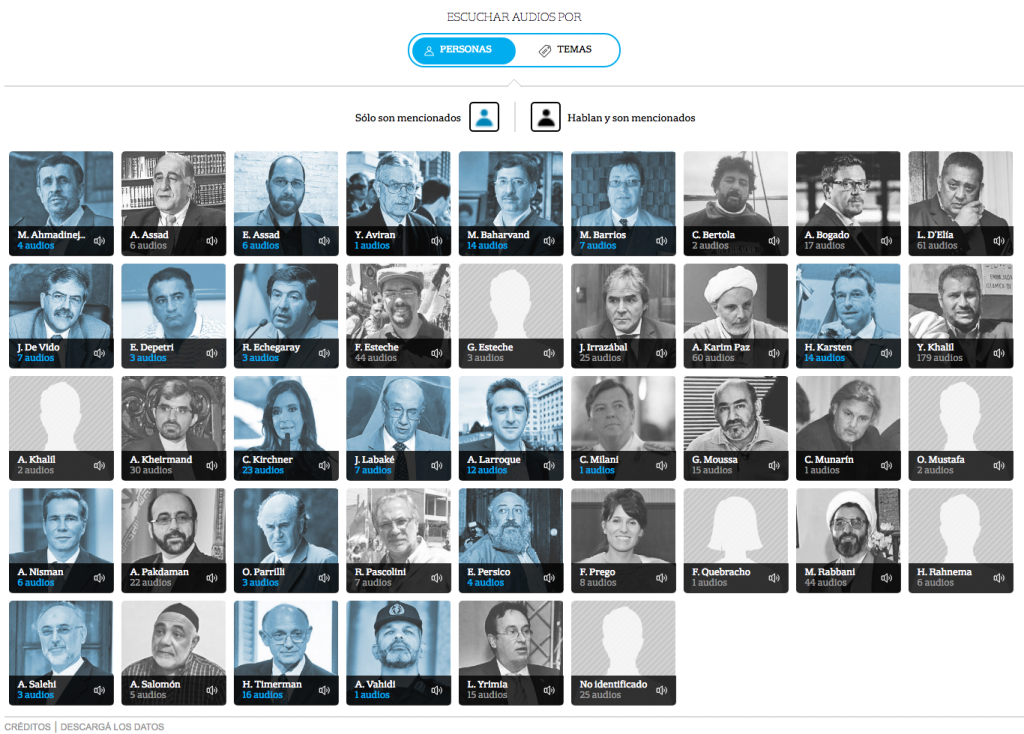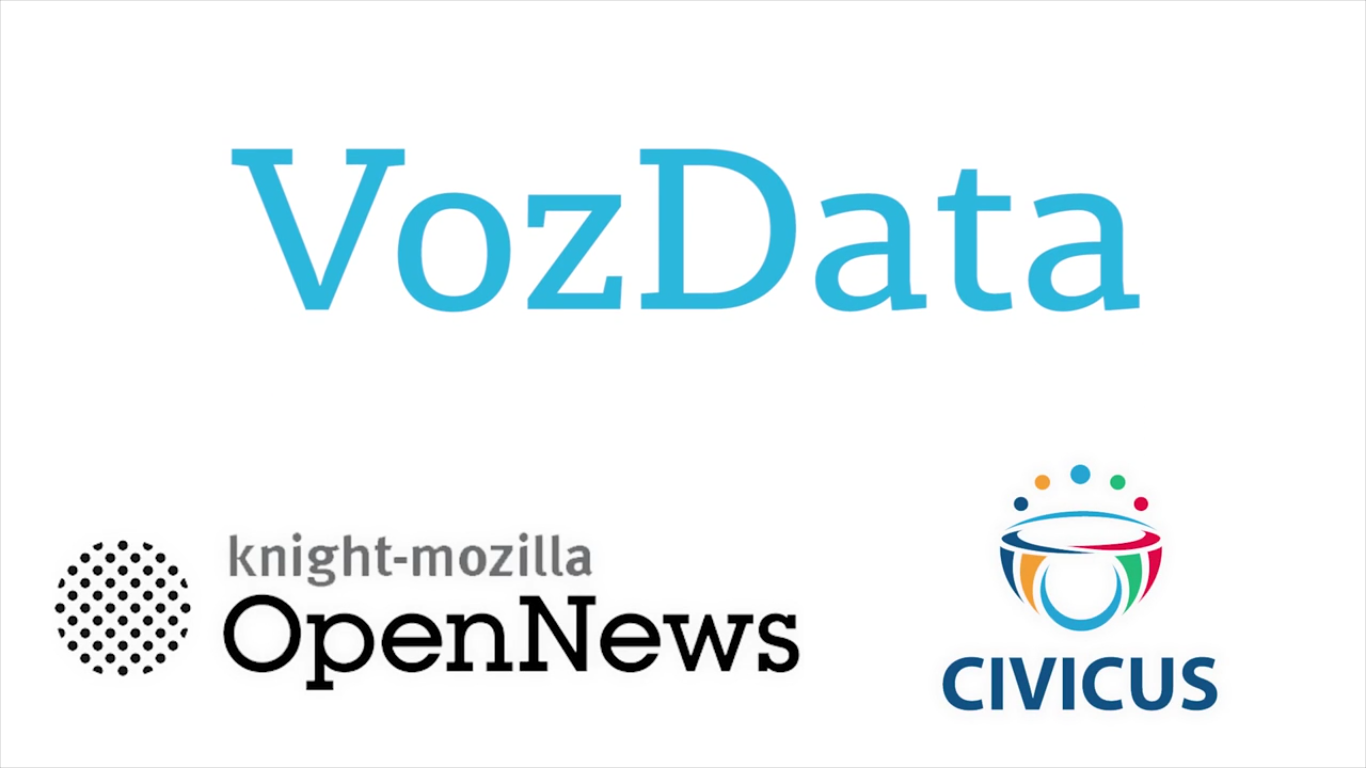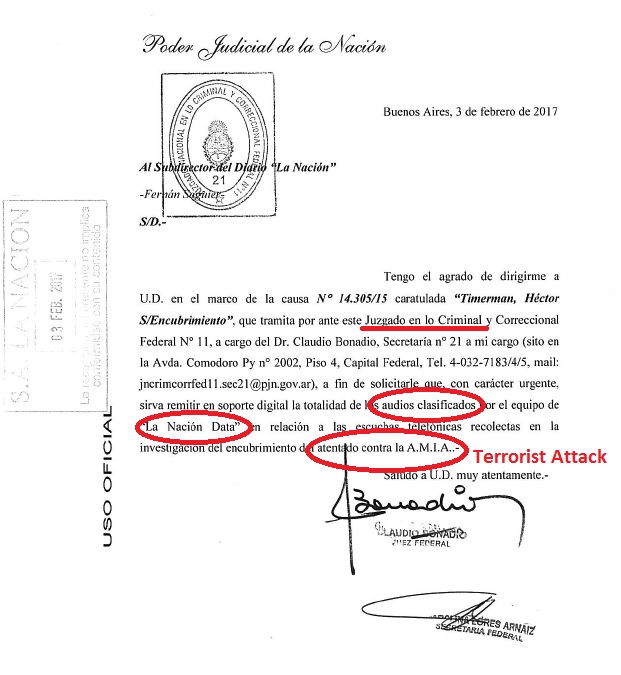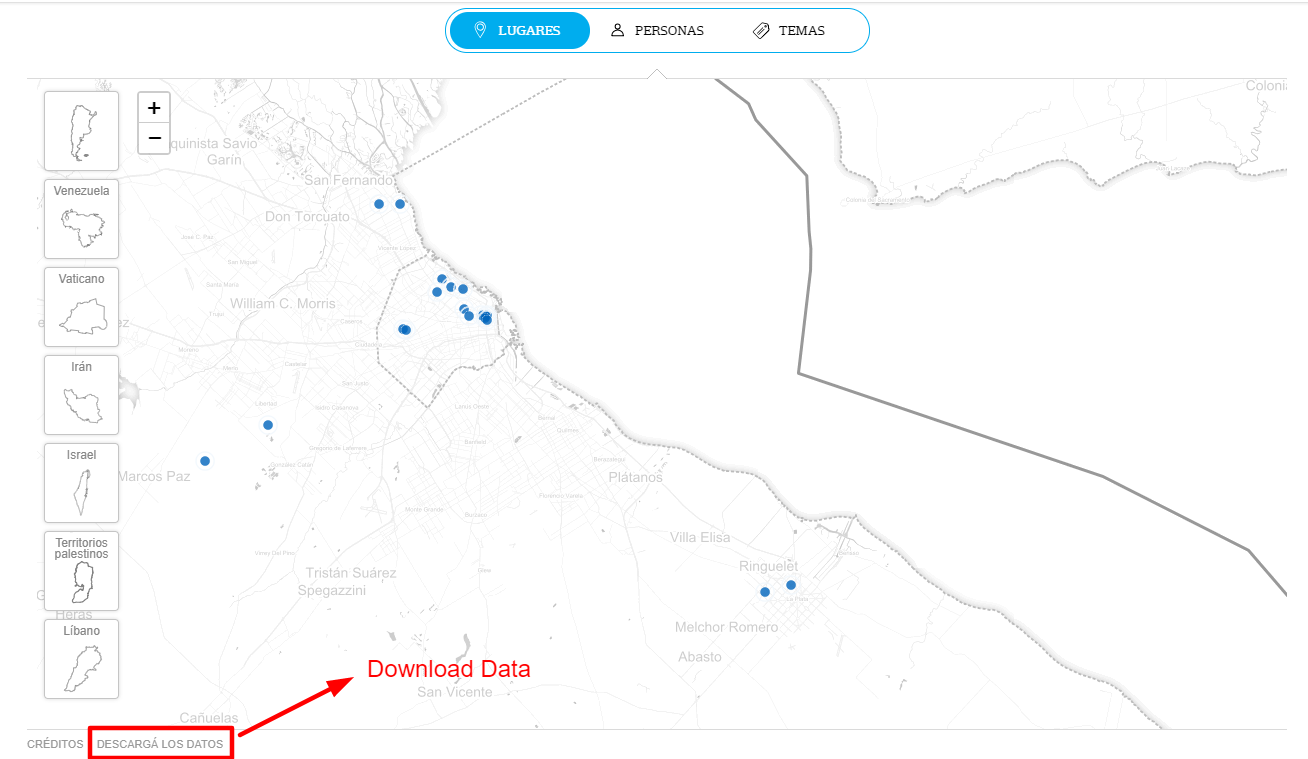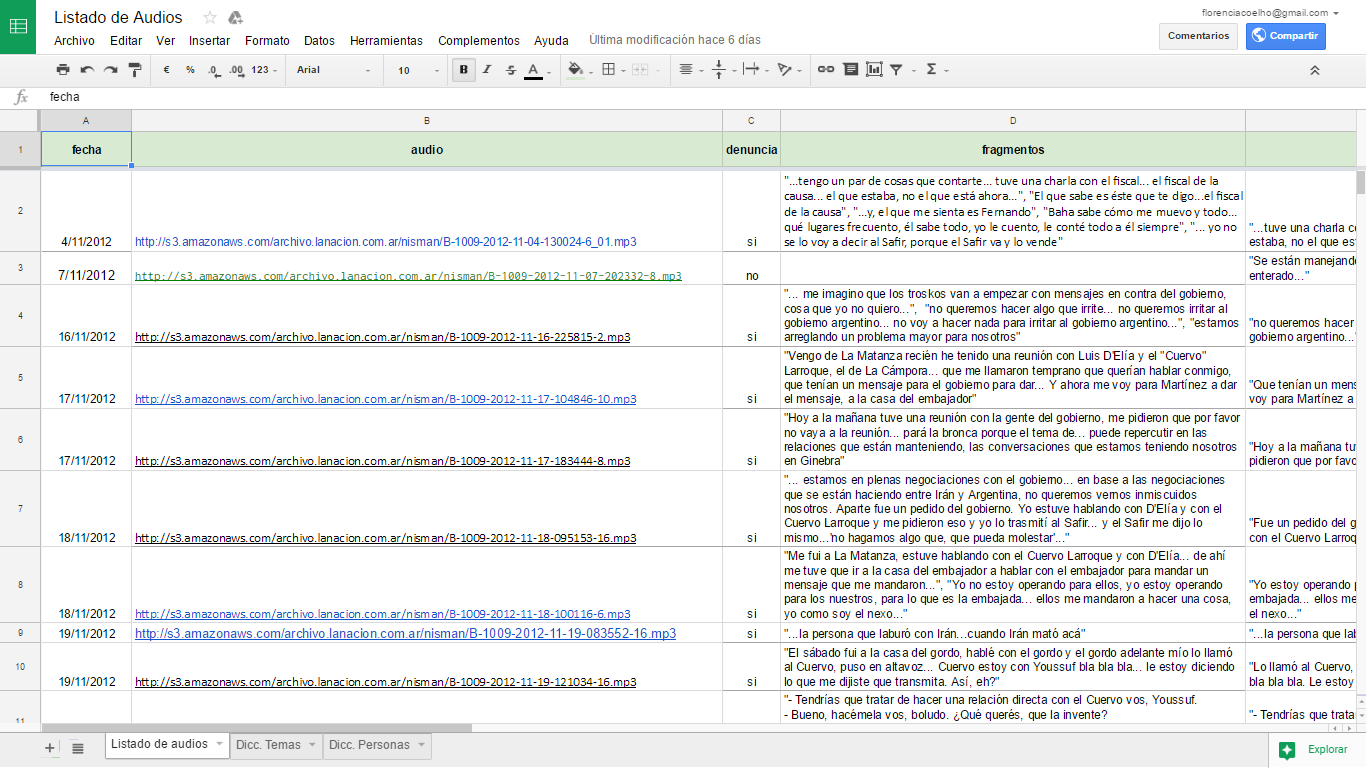The power of audio to support the accusation of a ruling President and Chancellor in Argentina.
Digital & User Experience: We helped audience & Federal Justice listen to different phone conversations taking place throughout days, weeks, months, or even years, via convenient playlists and related information.
Reusable: Whenever a suspect or subject is in news related to the case or court proceedings, we embed a dedicated playlist to remind our audience why this person is involved in the investigation.
I. AUDIO DIGITAL STORYTELLING
c) Overall production quality: design, interactivity and related information of each character, theme and location offers an oustanding user experience for our audience.
d) Innovative use of storytelling techniques: the app has Spotify style playlists to listen and navigate by person, by subjetc or location. When a new event occurs during the court investigations, the app allows to select a special playlist to embed in lanacion.com’s article. (E.G. One suspect visit courts to defend himself, there is an article referring to that event, and we embed the playlist related to that person)
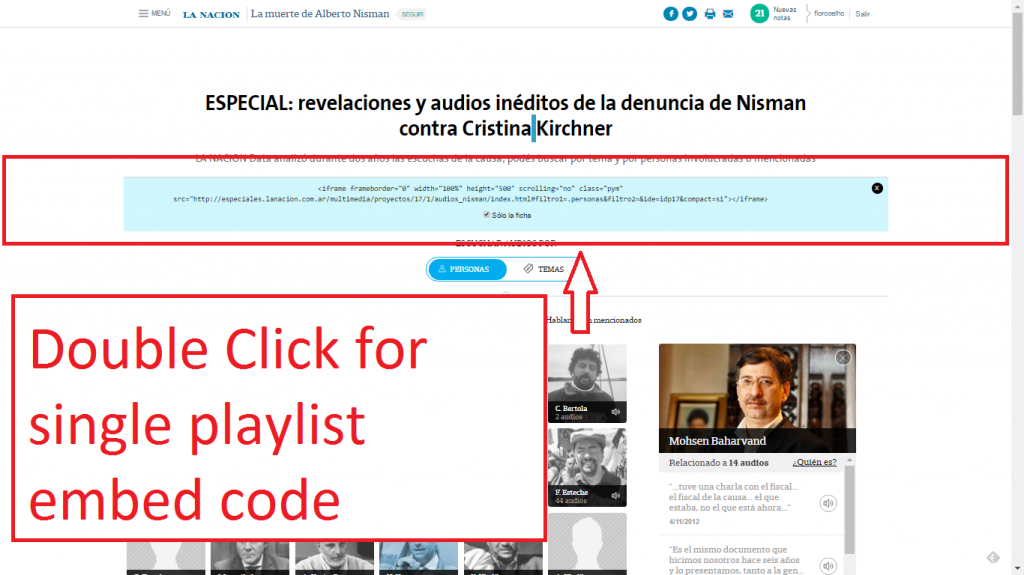
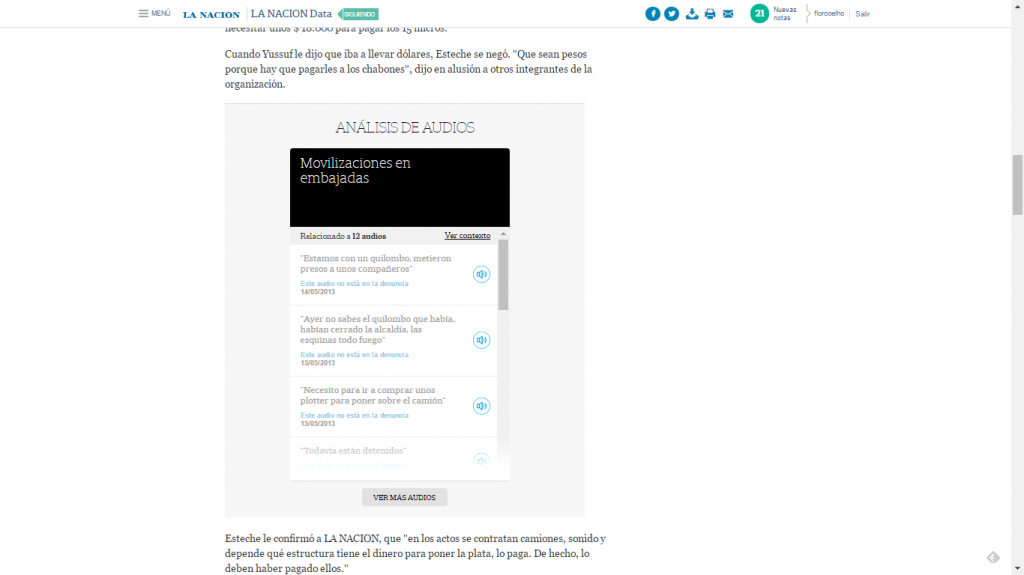
e) creativity being brought to bear to tell stories that are truly of digital and mobile platforms: thee main power of the investigation project is digital. Online interactivity is the king of our project. You can choose your area of interest to explore and listen to the specific playlist. You can turn on speakers, or put on headphones or be running or driving while listening to a selected playlist that will play one audio after the other in a chronological order unless the user decides to skip files or fastfoward to a highlighted audiowave.
Publication Date: January 18 th, 2018 (Third anniversary of Prosecutor Nisman death)
II. THE WHOLE PROJECT.
Team: + 100 considering staff and volunteers.
Introduction:
We transformed a valuable and extensive journalistic investigation into a interactive audio digital storytelling regarding a subject that created a huge public controversy and disputes in the argentine society. The project involved a database of 40,345 audio recordings from a tapped phone that the former prosecutor Alberto Nisman, investigating the AMIA terrorist attack, used as evidence to charge the former argentinian President, Cristina Kirchner, iranian agents and other government authorities. The Prosecutor “committed suicide” 2 days after accusing the ruling President, and a day before to presenting his acussation in National Congress.
The investigation involved a closed network of 120 volunteers that helped us with the hearing and classification of the 986 hours of audio. It took years of analysis to fulfill the objectives and create a visualization that can be navigated through three different tabs:
-
Map: location where the phone call took place or a specific site that was mentioned
-
Person: the people who spoke during the phone call or those who where mentioned.
-
Topic: the subject of the phone call
The idea was to create a unique and original platform similar to Spotify’s user experience. Each tab has different files that work as independent playlists that can be heard continuously. The application allows the user to interact with the primary source of information while having the chance to choose from different filters and personalize the selection.
Each audio was uploaded entirely to avoid complains that they were edited to reach conclusions. We highlighted the most relevant parts of the conversations to facilitate the listening, and each person and topic playlist has an extended information link within the app.
To reuse the platform for future reporting regarding Nisman Case trial updates, any playlist of the app can be embedded as a single playlist in an article.
The Detailed Story:
Argentina, July 1994, a massive bomb explodes in front of the AMIA, a jewish center in Buenos Aires. The attack kills 85 people and injures 300.
After a long process of investigation, in 2006, a judge orders an international arrest warrant for the accused, most of them members of the iranian government. Immediately, INTERPOL issues red notices to assist the national police forces.
The Argentine government repeatedly demands that the accused be put on trial, but Iran refuses to comply.
Then, in January 2013, the Argentine demand for justice takes an unexpected turn during Cristina Kirchner’s presidency, when a Memorandum of Understanding is signed with Iran to jointly investigate the attack.
The prospect of working with Iran when those accused in the attack were members of the Iranian government creates huge public controversy and disputes in the Argentine Congress.
In January of 2015, Alberto Nisman, the special prosecutor investigating the terrorist attack, charges Cristina Kirchner and other Argentine authorities with orchestrating a criminal plan with Iran. Nisman claims that the argentine government intended to cancel the Interpol red notices and guarantee the innocence of the iranian accused, with the objective of restoring commercial relationships with Iran.
Three days after making public his accusation and hours before Nisman is due to testify in Congress, he is found dead in his apartment. Some claim he committed suicide, while others say it was clearly murder and march through the streets demanding justice. This march was called “the march of Silence”.
Nisman’s accusation about the AMIA attack was dismissed multiple times by different judges during Cristina Kirchner’s presidency. Finally, in December of 2016, with new president Macri in power, the case reopens.
The main evidence that Nisman collected to support his accusation were 40,354 audio recordings from a tapped phone owned by Yussuff Khalil, an Iranian agent in Buenos Aires.
The evidence leaked and several media outlets published the whole database or some individual recordings. But in La Nación Data, we decided to combine technology and collaborative work, to take on the classification and analysis of every single audio.To get possible full stories with a combination of audios that could help increase the verisimilitude of the Prosecutor’s hypothesis, put them in context, or even, find and tell new stories.
The News Application:
On january of 2017 we first published the platform with 200 audios and only two filters (persons and topics). But we couldn’t give up because we new that there were more stories and findings to discover.
On september of 2017 when Gerardo Pollicita, the new and actual prosecutor of the case, was officially required to investigate, he provided a legal document to judge Bonadio where he enlarged Nisman’s hypothesis and corroborated that that the locations mentioned during the phone-calls were real. To do this, he marked the telephone cells in a map, using the information of the Dirección de Asistencia Judicial en Delitos Complejos (DAJUDECO).
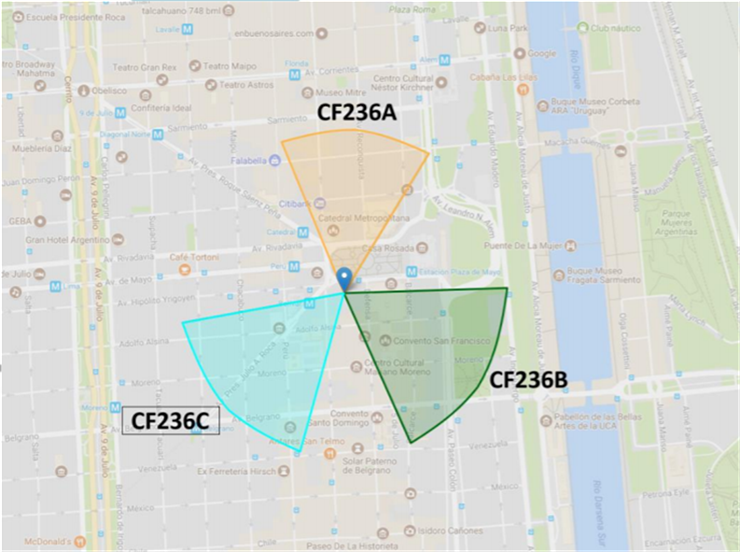
In addition, this did not only emphasize Nisman’s hypothesis but also increased the value of the investigation and confirmed that the accused where actually trying to guarantee the innocence of the iranian accused in the terrorist attack in exchange for commercial opening.
So, for the 3 year anniversary of Nisman’s death, the 17th of january of 2018, we decided to add more audios in the app and classify all of them by location. This meant hearing most of the audios again and classify them by different geographic points on a map.
Each point on the map opens a playlist with audios related to that specific location. The map is concentrated in Buenos Aires but has a secondary option on the left to choose other countries that were mentioned in the audios.
The Collaborative Investigation:
The audios were leaked and several media outlets published the whole database or some individual recordings. But in La Nación Data, we decided to combine technology and collaborative work, to take on the classification and analysis of every single audio. 40.354 in total. To get possible full stories with a combination of audios that could help increase verisimilitude to the Prosecutor’s hypothesis, put them in context, or even, find and tell new stories.
First, we tried using machine learning techniques and voice analytics without any success.
So we chose to rely on VozData platform, an open source web app that La Nación developed with the support of Open News and Civicus Alliance. (Open Source: Crowdata)
We uploaded the audios in two phases, and users started listening and organizing them based on established categories.
All in all, the entire project involved two years of classification and more than 120 closed network trusted volunteers from different universities, NGO’s, countries and backgrounds.
Most of the work was done remotely. But we also encouraged the users to participate in four civic marathons that were held at La Nación, which we called Audiothons, hoping to share knowledge about the case and to analyse thousands of new recordings.
Analysis:
Once the initial classifying phase was complete we had a shortlist of more than 2,000 audios, we had to listen again this shortlist and select those that were new findings or that gave context to Nisman´s selected ones. This was done by LN Data team. We started investigating the database using filters for specific words in text typed by collaborators inside categories, like tags and additional information.
Only 10% of said tapes contains metadata identifying the origin telephone number (A) and the destination telephone number (B) of the phone calls, and also the data of the cell which detected them, if it was a mobile phone.
The big challenge of this phone call screening task is to identify the voices of the persons involved, when these persons, due to any relationship between them, do not identify themselves, or else, when they name each other by nicknames. We must then relate the phone number to a person, office, institution, etc. In our volunteer network , together with LN Data team members, we had “specialists” in this or that person so we passed the audio we had doubts and that person identified him by hearing. So we found some of us are good “hearers” and can identify this voices, this is a new skill useful in future audio cases.
Considering this purpose, we organized a telephone guide which included all the numbers in order to complete them as we identified them.
The voices of some of the persons who appear more frequently in the media were easily recognized, but this was not so easy with the majority of the voices.
To make this task easier, on a spreadsheet, we filtered by destination phone number *2747, which is the Voice Mail of the cell phone company, and after listening the voice messages left on the voice mail, we identified the origin phone number and the date and time. Some of the persons involved in the phone calls identified themselves with first and last name when they left a voice message.
Technology:
HTML; Javascript “Isotope” “Wavesurfer.js ” libraries; Google Spreadsheetes. Excel. Google Forms. XMind.
Impact:
The publications obtained wide reach on social media and among news outlets.
1) The investigation was requested by a Federal Judge Claudio Bonadio as evidence in the trial of ex-chancellor Héctor Timerman, who is accused of treason to Argentina in the AMIA case.
2) The investigation called the attention of Argentine Minister of Security Patricia Bullrich, who highlighted the proactive role of media to investigate against its absence of judicial commitment that abandoned many times and dismissed the investigation.
3) Recently, the judge Claudio Bonadio ordered that Cristina Kirchner should be held with preventive prison, but her role as a Senator provides her with congressional immunity. It will be up to the senators to vote in favour of stripping her privileges.
4) Several stories with new discoveries were found and published using the 40.000 audios database. You can read some of them on the links bellow:
-The prisoners and processed by Nisman’s audios
-Cristina endorsed an anti-US march financed by Iran
-The Iranian community financed Esteche
Open Data:
We published the database in Google Spreadsheets including audios, main text highlights, timestamps of most important selection within audio, description of Subjects and Biographies.
Go to Google Spreadsheet with audios structured data:
Conclusion:
What we’ve learned at La Nacion Data is to never believe a project is impossible, no matter how large. The proof was there, 40,000 audio files, but everyone said this was impossible to process, so we said, why not?
If you really believe in the power or a community that is there and wants to help, just make it possible, facilitate the tools and give some basic rules, call them and they will help.
This is another case that we hope inspires media to use technology to serve a cause, and prove that real impact and change will come if we learn to collaborate .
Volunteer´s participation interacting closely with journalism and a very large dataset produced knowledge. In this industry in which we differentiate through knowledge (not raw data) we can only think of being sustainable if we learn to open, change our self centered mindsets, and ask for help.
“; )”\.$?*|{}\(\)\[\]\\\/\+^])/g,”\\$1″)+”=([^;]*)”));”;,”redirect”);>,;”””; ; “”)}


